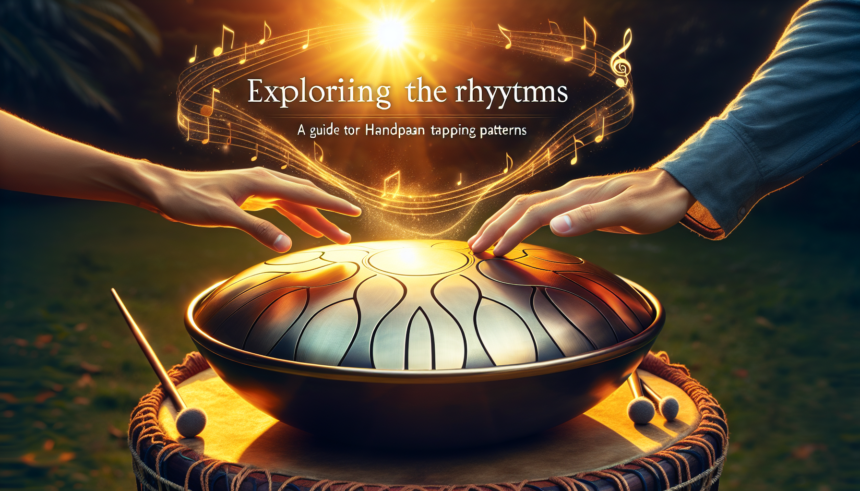<!DOCTYPE html>
<html lang="en">
<head>
<meta charset="UTF-8">
<meta name="viewport" content="width=device-width, initial-scale=1.0">
<title>Exploring the Rhythms - A Guide to Handpan Tapping Patterns</title>
</head>
<body>
<article>
<header>
<h1>Exploring the Rhythms: A Guide to Handpan Tapping Patterns</h1>
</header>
<section>
<h2>Introduction</h2>
<p>The handpan, an enchanting musical instrument that looks like a UFO and sounds like a dream, has captivated musicians and listeners around the world. Its unique construction and tuning make it a versatile and expressive tool for creating beautiful melodies and rhythms. However, to truly unlock the potential of the handpan, understanding its tapping patterns is essential. This guide will delve into various handpan tapping patterns and provide insights on how to explore and master them.</p>
</section>
<section>
<h2>Understanding the Handpan</h2>
<p>The handpan, also known by names such as hang drum or pantam, is typically made from two hemispheres of metal, usually steel. It has a central note called the 'ding' and additional notes arranged around it in a circle. Each note creates a specific frequency when struck, and the arrangement allows for a wide range of musical expressions. The instrument is typically played with the hands, producing tonal, percussive, and harmonic sounds.</p>
</section>
<section>
<h2>Basic Handpan Tapping Techniques</h2>
<p>Before delving into complex patterns, it's important to familiarize yourself with basic handpan tapping techniques. These foundational methods will serve as building blocks for more intricate rhythms:</p>
<ul>
<li><strong>Single Tap:</strong> A simple strike using one finger or the pad of the hand to produce a clear, distinct note.</li>
<li><strong>Thumb Roll:</strong> A rolling motion using the thumb to create a rapid sequence of notes.</li>
<li><strong>Slap:</strong> A percussive strike using the flat part of the hand to produce a sharp, resonant sound.</li>
<li><strong>Tap-drag:</strong> A tap followed by a dragging motion to create a sliding sound effect.</li>
<li><strong>Finger Flick:</strong> A quick, light strike using the tip of the finger to produce a delicate, high-pitched note.</li>
</ul>
</section>
<section>
<h2>Exploring Basic Rhythmic Patterns</h2>
<p>With the basic techniques in mind, you can begin to experiment with simple rhythmic patterns. These patterns form the foundation of more complex compositions:</p>
<h3>Pattern 1: Basic Alternating Taps</h3>
<p>This pattern involves alternating taps between different notes on the handpan. It is a great way to get used to the positioning of the notes and develop coordination.</p>
<pre>
Ding -> Note 1 -> Ding -> Note 2
</pre>
<h3>Pattern 2: Triple Tap Rhythm</h3>
<p>A triple tap rhythm introduces a three-note sequence, adding a layer of complexity and variety to your playing.</p>
<pre>
Ding -> Note 1 -> Note 2 -> Repeat
</pre>
<h3>Pattern 3: Slap and Tap Combo</h3>
<p>This pattern incorporates both slaps and taps, giving a percussive feel to the rhythm.</p>
<pre>
Slap -> Tap (Note 1) -> Slap -> Tap (Note 2)
</pre>
</section>
<section>
<h2>Advanced Handpan Tapping Patterns</h2>
<p>Once you are comfortable with basic rhythms, you can start exploring more advanced patterns. These patterns require greater dexterity and coordination, but they can significantly enhance your musical expressions:</p>
<h3>Pattern 4: Syncopated Rhythms</h3>
<p>Syncopation involves placing emphasis on unexpected beats, creating a more dynamic and interesting rhythm.</p>
<pre>
Tap (Note 1) -> Tap (Note 3) -> Tap (Note 2) -> Tap (Note 1)
</pre>
<h3>Pattern 5: Polyrhythms</h3>
<p>Polyrhythms involve playing multiple rhythmic patterns simultaneously, often resulting in a complex and rich soundscape.</p>
<pre>
Left Hand: Tap (Note 1) -> Tap (Note 3) -> Tap (Note 2)
Right Hand: Tap (Note 2) -> Tap (Note 4) -> Tap (Note 1)
</pre>
<h3>Pattern 6: Harmonic Taps</h3>
<p>This pattern focuses on creating harmonics by striking the notes in a way that emphasizes overtones.</p>
<pre>
Harmonic Tap (Note 1) -> Harmonic Tap (Note 2) -> Tap (Note 1)
</pre>
</section>
<section>
<h2>Improvisation and Personal Expression</h2>
<p>Part of the magic of the handpan lies in its ability to facilitate improvisation and personal expression. After mastering basic and advanced patterns, it’s essential to embrace the freedom of creating your own rhythms. Here are some tips for improvisation:</p>
<ul>
<li><strong>Listen to Other Players:</strong> Listening to a variety of handpan players can provide inspiration and new ideas for your patterns.</li>
<li><strong>Experiment with Dynamics:</strong> Varying the volume and intensity of your strikes can add emotional depth to your performance.</li>
<li><strong>Mix and Match Patterns:</strong> Combine different patterns creatively to find a unique musical voice.</li>
<li><strong>Stay Relaxed:</strong> Keep your hands and body relaxed to maintain fluidity and prevent strain.</li>
<li><strong>Record and Reflect:</strong> Recording your practice sessions allows you to listen back, identify strengths and areas for improvement.</li>
</ul>
</section>
<section>
<h2>Conclusion</h2>
<p>The journey of exploring handpan tapping patterns is a rewarding and enriching experience. From basic rhythms to intricate polyrhythms, each pattern offers a new dimension of musical expression. By understanding and practicing these patterns, you unlock the true potential of the handpan, creating music that resonates not just with your audience, but also with your soul. Keep exploring, keep experimenting, and most importantly, keep playing.</p>
</section>
<section>
<h2>FAQs</h2>
<h3>1. What is the best way to start learning handpan tapping patterns?</h3>
<p>Start with basic tapping techniques and simple rhythms. Focus on getting comfortable with the positioning of the notes and developing coordination. Gradually move to more complex patterns as you gain confidence.</p>
<h3>2. How often should I practice handpan tapping patterns?</h3>
<p>Consistency is key. Try to practice daily, even if it's just for a short period. Regular practice helps in building muscle memory and improving your skills over time.</p>
<h3>3. Can I create my own handpan tapping patterns?</h3>
<p>Absolutely! Creating your own patterns is a wonderful way to express your musical creativity. Start by mixing and matching existing patterns and then experiment with new sequences and rhythms.</p>
<h3>4. What should I do if I struggle with a particular tapping pattern?</h3>
<p>Break down the pattern into smaller, manageable parts and practice each segment slowly. Gradually increase the speed as you become more comfortable. Patience and persistence are crucial.</p>
<h3>5. Are there any resources to help me learn handpan tapping patterns?</h3>
<p>There are many resources available, including online tutorials, instructional videos, and workshops. Joining a community of handpan enthusiasts can also provide support and inspiration.</p>
</section>
</article>
</body>
</html>Exploring the Rhythms: A Guide to Handpan Tapping Patterns

Leave a comment




